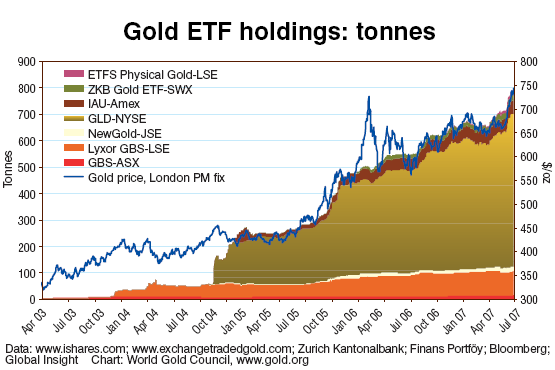What is an ETF?
The shares of an Exchange Traded Fund (ETF) are traded publicly on a stock exchange. They are designed to reflect the price movement of their underlying assets, whether those assets are stocks, bonds, or commodities.
Why invest in a Gold ETF?
Many investors don’t have the ability to store actual gold, nor do they want the inconvenience or risk associated with doing so. However, gold should be seen as a necessary component of a diversified investment portfolio, and when circumstances dictate an overweight or underweight position should be taken accordingly.
Many gold ETFs are backed by physical gold. For investors they offer a quick and cost effective way of gaining exposure to the gold price movement without taking a position in the physical gold itself.
For Bull Markets and Bear Markets
Whilst most gold ETFs give exposure to the upside potential of the gold price, all investors understand that markets move down as well as up. There are gold ETFs that offer investors a way to profit from a falling gold price in addition to the more common long side ETFs. They do this by investing funds in a range of derivative instruments – options and futures – to create a short side exposure to physical gold and its price movement.
Some ETFs, both long side and short side, give a double exposure to the gold price movement – that is they are intended to move by twice the daily change, up or down, of the gold price.
Exposure to Gold Industrial Sectors
Unlike owning physical gold, ETFs enable investors to gain exposure to the industries that rely on gold. For example, an investor who wants to invest in gold mining stocks may decide to buy the shares of a range of gold mining companies. This will give him the required exposure, whilst not being overweight in any one stock: he would be diversified within the gold mining sector. The downside to such an operation is the number of potentially small trades the investor will need to execute which can be costly and time consuming. The same is true ‘on the way out’, when the investor wants to sell his holdings.
An ETF based on the underlying holdings of the share of gold mining companies would give the investor similar diversification and the exposure he desires through one simply executed, cost efficient, trade. This position is similarly easily reduced by a full or partial sale in a single trade.
Using Gold ETFs to Hedge Exposure
As well as gaining exposure to gold or a gold industrial sector, ETFs can be used to hedge a portfolio or a physical gold holding itself.
If an investor with a physical gold holding believes that the gold price will suffer a short term fall, rather than sell the gold holding, incurring the costs of doing so, he could buy a short side ETF. Once the expected downward move has materialised, the investor can close out his position in the short side ETF and book a profit against his paper loss in his physical gold holding.
Holding an ETF is not like Holding Physical Gold
Many gold ETFs hold gold futures or other derivatives rather than physical gold. Even if invested in a gold ETF that is backed by a store of gold, the ETF holder cannot exchange his ETF shares for the physical gold. He can only sell the ETFs and realise cash (perhaps to purchase gold bars or rounds).
An investor in gold ETFs should always check the tax position on doing so. In some jurisdictions, gold ETFs are treated differently to other ETFs and gold for tax purposes.
In Conclusion
Though investors should always conduct their own research, and seek advice, gold ETFs offer a simple and cost efficient method of gaining exposure to the price movement of gold. They can be used for speculative or hedging purposes, as well as for investment or portfolio diversification. Publicly traded on stock exchanges, they are transparent financial instruments that investors can use to their advantage. For more information, you can also read our article Physical Gold vs. ETFs.





